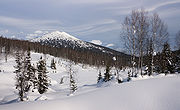
Kuznetsk Alatau
Encyclopedia


Mountain range
A mountain range is a single, large mass consisting of a succession of mountains or narrowly spaced mountain ridges, with or without peaks, closely related in position, direction, formation, and age; a component part of a mountain system or of a mountain chain...
, South Siberia
Siberia
Siberia is an extensive region constituting almost all of Northern Asia. Comprising the central and eastern portion of the Russian Federation, it was part of the Soviet Union from its beginning, as its predecessor states, the Tsardom of Russia and the Russian Empire, conquered it during the 16th...
, Russia
Russia
Russia or , officially known as both Russia and the Russian Federation , is a country in northern Eurasia. It is a federal semi-presidential republic, comprising 83 federal subjects...
between Kuznetsk Depression
Kuznetsk Depression
Kuznetsk Depression is located among mountains of Southern Siberia: Kuznetsk Alatau to the Northeast, Salair Ridge to the Southwest, and Mountainous Shoria to the South. Elevation up to 500 m, area: 70,000 km², length: 400 km, width: 120 km....
and Minusinsk Depression. Length: about 300 km., elevation: up to 2178 metres (7,146 ft). It is part of the mountain system of Central Asia
Central Asia
Central Asia is a core region of the Asian continent from the Caspian Sea in the west, China in the east, Afghanistan in the south, and Russia in the north...
. See Geography of South-Central Siberia
Geography of South-Central Siberia
This article covers the region of Siberia west of Lake Baikal and north of the Altai Mountains. It is intended totie together a number of articles that are hard to understand in isolation....
.
These mountains have smooth outline, rather steep western and gentle eastern slopes. The fir
Fir
Firs are a genus of 48–55 species of evergreen conifers in the family Pinaceae. They are found through much of North and Central America, Europe, Asia, and North Africa, occurring in mountains over most of the range...
overwhelmingly predominates in the forest belt except for its upper part where, at the tree line (1300-1900 m), the pine
Siberian Pine
The Siberian Pine, Pinus sibirica, in the family Pinaceae is a species of pine tree that occurs in Siberia from 58°E in the Ural Mountains east to 126°E in the Stanovoy Range in southern Sakha Republic, and from Igarka at 68°N in the lower Yenisei valley, south to 45°N in central...
becomes a dominant. The highlands are occupied mostly by vast large-stoned screes, and also by patches of subalpine meadows and, on some southern mountain massifs, of bushy, lichen and moss tundra
Tundra
In physical geography, tundra is a biome where the tree growth is hindered by low temperatures and short growing seasons. The term tundra comes through Russian тундра from the Kildin Sami word tūndâr "uplands," "treeless mountain tract." There are three types of tundra: Arctic tundra, alpine...
s. The basin of the Kondoma River
Kondoma River
Kondoma is a river in Kemerovo Oblast, Russia. It is a left tributary of the Tom River. It is 392 km long, with a drainage basin of 8,270 km². The towns of Tashtagol, Osinniki and Kaltan is situated by the Kondoma. Its main tributaries are the Mundybash, Tesh, and Telbes Rivers....
in Gornaya Shoriya
Mountain Shoria
Mountain Shoria, Mountainous Shoria, or Gornaya Shoria is a territory in southern Siberia, Russia, east of the Altay Mountains. It is the southern part of Kemerovo Oblast. The indigenous population are the Shors people....
is remarkable for the lime-tree
Tilia
Tilia is a genus of about 30 species of trees native throughout most of the temperate Northern Hemisphere. The greatest species diversity is found in Asia, and the genus also occurs in Europe and eastern North America, but not western North America...
woods which are thought to be the relics of a pre-Pleistocene
Pleistocene
The Pleistocene is the epoch from 2,588,000 to 11,700 years BP that spans the world's recent period of repeated glaciations. The name pleistocene is derived from the Greek and ....
nemoral vegetation of Siberia. All over the upland the forest openings are occupied by long forb forest meadows.
The range is composed mainly of metamorphic rock
Metamorphic rock
Metamorphic rock is the transformation of an existing rock type, the protolith, in a process called metamorphism, which means "change in form". The protolith is subjected to heat and pressure causing profound physical and/or chemical change...
s rich in iron
Iron
Iron is a chemical element with the symbol Fe and atomic number 26. It is a metal in the first transition series. It is the most common element forming the planet Earth as a whole, forming much of Earth's outer and inner core. It is the fourth most common element in the Earth's crust...
, manganese
Manganese
Manganese is a chemical element, designated by the symbol Mn. It has the atomic number 25. It is found as a free element in nature , and in many minerals...
, nepheline
Nepheline
Nepheline, also called nephelite , is a feldspathoid: a silica-undersaturated aluminosilicate, Na3KAl4Si4O16, that occurs in intrusive and volcanic rocks with low silica, and in their associated pegmatites...
s, and gold
Gold
Gold is a chemical element with the symbol Au and an atomic number of 79. Gold is a dense, soft, shiny, malleable and ductile metal. Pure gold has a bright yellow color and luster traditionally considered attractive, which it maintains without oxidizing in air or water. Chemically, gold is a...
.

